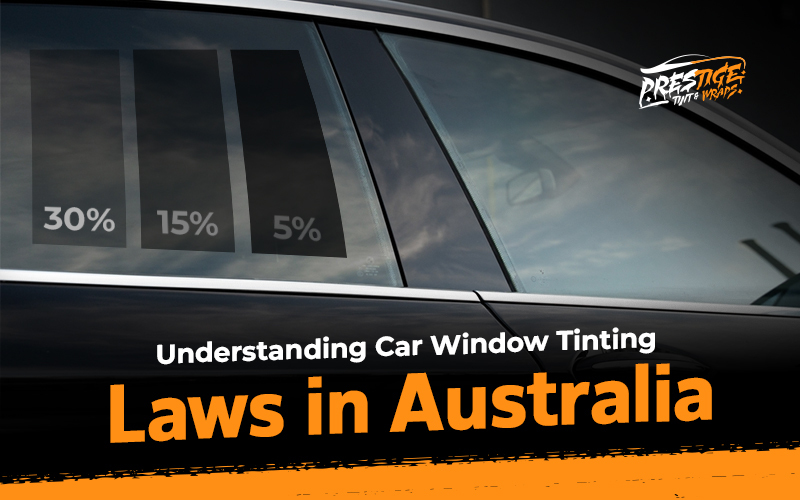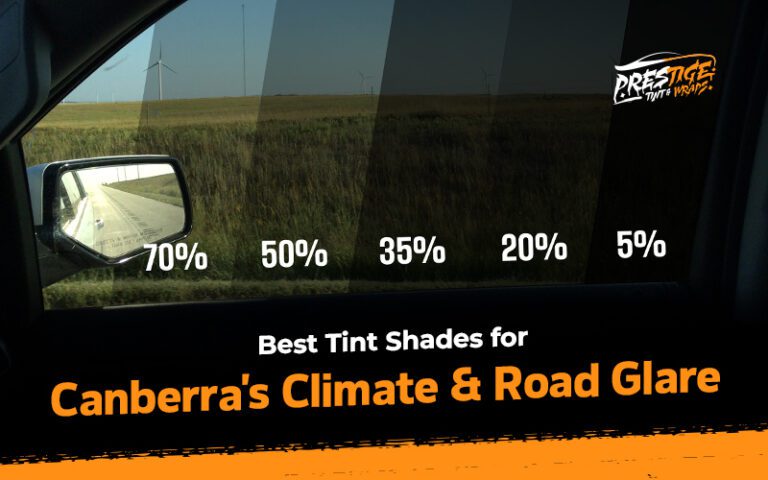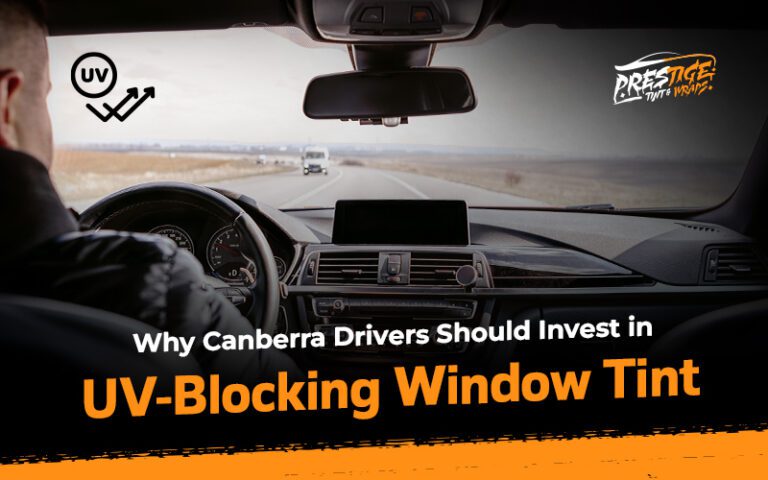Understanding Car Window Tinting Laws in Australia

Car window tinting offers many benefits. It enhances privacy. It reduces heat inside your vehicle. It also protects against harmful UV rays.
But navigating the legal landscape of window tinting Australia can be tricky. Each state has specific rules.
These rules dictate how dark your car windows can be. Knowing these regulations is crucial. It helps you avoid fines. It also ensures your safety on the road.
What is VLT? Understanding Visible Light Transmission
Here’s a clear and simple table explaining VLT (Visible Light Transmission) based on your content:
| VLT (%) | Light Transmission | Tint Appearance | Common Name | Notes |
| 100% | All light passes through | No tint | Clear Glass | Rare for automotive use |
| 70–80% | Most light passes through | Very light tint | Factory Tint | Common in front windows of many vehicles |
| 50% | Half the light passes through | Light tint | — | Often used for subtle tinting |
| 35% | Moderate light transmission | Medium tint | — | Popular balance between privacy and visibility |
| 20% | Low light transmission | Dark tint | — | Offers privacy, still street-legal in some states |
| 5% | Very little light passes through | Very dark tint | Limo Tint | Mostly illegal for front windows; popular for rear windows and limos |
Additional Notes:
- Final VLT = Factory Glass VLT × Tint Film VLT
(Example: Factory glass 70% + 35% tint film ≈ 24.5% final VLT) - Professional auto detailers in Australia use VLT meters to ensure legal compliance.
Why Are There Tinting Laws?
Tinting laws exist for several reasons. Safety is paramount. Drivers need clear visibility. This is especially true at night or in bad weather.
Very dark tints can impair vision. This increases accident risk. Law enforcement also needs to see inside vehicles. This is important for officer safety.
It helps in identifying occupants during traffic stops. These laws balance privacy with public safety. They aim for a safe driving environment for everyone.
Darkest Legal Tint
Australia’s states and territories have varying tinting regulations. It’s important to check the rules for your specific location. Here’s a detailed look at some major states:
New South Wales (NSW)
In NSW, the rules are clear. For the front side windows, a minimum of 35% VLT is required. These are the driver’s window and the front passenger’s window. This means at least 35% of visible light must pass through.
For the rear side windows and the rear window, a darker tint is allowed. You can go as dark as 20% VLT. This provides more privacy for rear passengers.
The front windscreen has strict rules. No tint film is permitted on the main part of the windscreen. However, a small sun strip is allowed.
This strip can be applied to the top portion. It must not extend below the highest point swept by the windscreen wipers. This ensures the driver’s primary field of vision remains clear. If your car has factory-tinted privacy glass, be careful.
If the combined VLT of the glass and any added film falls below 20%, it’s illegal. Always consult with expert auto detailers Australia to ensure compliance.
Victoria
Victoria’s tinting laws are quite similar to NSW. Front side windows must have a minimum of 35% VLT. This applies to the windows immediately to the left and right of the driver.
For the rear side windows and the rear window, a 20% VLT is permitted. This allows for increased privacy and heat reduction in the back of the vehicle.
Regarding the front windscreen, no tinting is allowed on the main area. Like NSW, a tinted band is permitted. This band must be less than 70% VLT.
It can be applied to the top 10% of the windscreen. Alternatively, it can be above the highest point swept by the wiper arc. Whichever is greater. This helps reduce glare without compromising critical visibility.
Victoria also prohibits tint films with more than 10% reflectance. Bubbling or distortion of the tint film is also illegal. Choosing the best car window tinting Australia service ensures these details are handled correctly.
Queensland
Queensland also has specific rules for car window tinting. Front side windows must have a VLT of no less than 35%. This is consistent with other states.
For the rear side windows and the rear window, a darker tint is permitted. The VLT must not be lower than 20%. This provides a good balance of privacy and visibility.
The front windscreen rules in Queensland are strict. Only the upper 10% of the windshield may be tinted. This strip must not impede the wiper arch.
It helps reduce sun glare. The rest of the windscreen must remain untinted. This ensures maximum visibility for the driver. Queensland also emphasizes that if your car has factory-dyed privacy glass, any additional tint must still comply.
The combined VLT must meet the 20% VLT for rear windows and 35% VLT for front windows.
Benefits of Legal Window Tinting
Even with legal limits, window tinting offers substantial benefits.
Heat Reduction
Quality window tinting significantly reduces heat. It blocks solar energy from entering your car. This keeps the interior cooler. It reduces the need for air conditioning.
This can lead to fuel savings. It makes your drive more comfortable. Especially during hot Australian summers. Many people seek window tinting Australia for this reason alone.
UV Protection
Harmful UV rays can damage your skin. They can also fade and crack your car’s interior. Window tinting blocks up to 99% of these UV rays. This protects you and your passengers.
It also preserves your car’s upholstery and dashboard. This adds to the longevity of your vehicle’s interior. It’s a smart investment for your health and your car.
Glare Reduction
Sun glare can be dangerous. It can impair your vision while driving. Headlight glare at night is also an issue. Tinted windows reduce this glare. They improve visibility.
This makes driving safer and more comfortable. It reduces eye strain on long journeys. This is a key benefit of professional window tinting Australia.
Enhanced Privacy and Security
Tinted windows offer increased privacy. They make it harder for outsiders to see into your car. This can deter thieves. It protects your belongings.
It also gives you a sense of personal space. This is particularly appealing for families. It’s also great for those who carry valuables.
Aesthetic Appeal
Beyond practical benefits, tinting improves your car’s look. It gives a sleek, sophisticated appearance. It can make your vehicle stand out.
Many car owners choose tinting for its aesthetic enhancement. It adds a touch of class and style. This is why many seek the best car window tinting Australia has to offer.
Choosing the Right Tint Film
There are different types of tint films available. Each offers unique properties.
Dyed Films
Dyed films are the most basic and affordable. They absorb solar heat. This helps to keep the car cooler. They also provide privacy. However, they can fade over time. They may not offer the best heat rejection.
Metallized Films
Metallized films contain tiny metallic particles. These particles reflect heat and UV rays. They offer superior heat rejection. They are also more durable.
However, they can interfere with electronic signals. This includes GPS, radio, and mobile phone reception. This is something to consider.
Carbon Films
Carbon films contain carbon particles. They offer excellent heat rejection. They also provide a matte finish. They do not interfere with electronic signals.
They are durable and resist fading. They are a popular choice for many car owners.
Ceramic Films
Ceramic films are the highest quality option. They contain ceramic particles. These particles are non-metallic. They block a significant amount of heat and UV rays. They do not interfere with electronic signals. They are highly durable.
They offer superior clarity. Ceramic tints are often considered the best car window tinting Australia option. They come at a higher price point. But their performance justifies the cost for many.
The Importance of Professional Installation
DIY tinting kits are available. However, professional installation is highly recommended.
Expertise and Experience
Professional auto detailers Australia have the expertise. They know the legal requirements for each state. They use specialized tools. They have years of experience.
This ensures a flawless application. They can advise on the best car window tinting Australia options for your vehicle.
Quality Materials
Reputable tinting services use high-quality films. These films are durable. They offer superior performance. They come with warranties. This ensures your investment is protected. They know which films are best for window tinting Australia.
Proper Application
Tinting requires precision. Bubbles, creases, or peeling are common with DIY jobs. Professionals ensure a smooth, clean finish.
They work in controlled environments. This minimizes dust and contaminants. This results in a perfect, long-lasting tint. They also ensure the VLT is exactly compliant. This avoids legal issues later.
Avoiding Legal Issues
A professional installer will ensure your tint complies with local laws. They use VLT meters to verify the tint darkness. This peace of mind is invaluable.
It saves you from potential fines. It prevents the hassle of removing non-compliant tint. This is a crucial aspect of window tinting Australia.
What Happens if Your Tint is Illegal?
Driving with illegal window tint can lead to penalties.
Fines
Police can issue fines. The amount varies by state. These fines can be substantial. They add up quickly.
Defect Notices
You might receive a defect notice. This requires you to remove the illegal tint. You then need to present your vehicle for inspection. Failing to comply can lead to further penalties.
Insurance Issues
Illegal modifications can void your insurance policy. If you’re in an accident, your insurer might refuse a claim. This could leave you with significant financial burden. Always ensure your window tinting Australia is legal.
Maintenance of Tinted Windows
Proper care extends the life of your window tint.
Waiting Period
After installation, avoid rolling down your windows. Wait at least 3 to 5 days. This allows the adhesive to cure properly. This is a critical step.
Cleaning
Use ammonia-free cleaners. Ammonia can damage the tint film. Use a soft cloth or paper towel. Avoid abrasive materials. Gentle cleaning keeps your tint looking new.
Avoid Sharp Objects
Be careful with sharp objects near your windows. Rings, keys, or bags can scratch the tint. Scratches can compromise the film’s integrity. They also look unsightly.
Conclusion
Understanding the darkest legal tint for your car is essential. It ensures you comply with state laws. It also maximizes the benefits of tinting. Whether you’re in NSW, Victoria, or Queensland, the rules are designed for safety. Always choose reputable auto detailers Australia for installation. They provide quality films and expert service. They ensure your tint is legal and long-lasting. Investing in the best car window tinting Australia has to offer is wise. It protects you, your passengers, and your vehicle. Enjoy the comfort, privacy, and style that legal window tinting provides.
For more info and professional window tinting as per law in Australia connect with Prestige Tint & Wraps, Trusted by Hundreds of Aussie Car Owners.



